We’re in danger, sleeping with a friend…
Type: Single-player
Genre: Visual Novel
Developer: Fan-na
Publisher: Sekai Project
Release date: 8 May, 2020


Intro
Real Life Plus is a visual novel dating sim, but, possibly in response to complaints about the genre being all harems, this game features not five, not six, not twelve, but ONE romanceable character. For that matter, it has one character that appears on-screen, period, unless you count the child that appears if you get the “they had a kid” ending. The whole game is basically Kouichi, the unvoiced player character and his childhood friend and love interest, the titular Kaname, voiced by Mao Sakazaki speaking to you for the whole game. It’s a pretty heavy lift to pin the game entirely upon a single voice actress who has to voice four different age categories of the same character, but I definitely wound up enjoying myself with this one.
Real Life Plus opens every chapter/time period with an announcement of the year the game is currently taking place in, which the game very much doesn’t want you to forget. At times (especially early on), the game is less about the characters themselves and more about wallowing in nostalgia for the era. I have little doubt that the game starts with an announcement that it’s 1999 (and the characters complaining that Nostradamus’s prediction that the world would face a cataclysm was wrong) when they’re first graders because the game’s sole writer just so happened to also be that age at that time because half the game consists of various video games, animes, and manga references and name-dropping that mostly exist to glorify a fictional childhood that you pretty much need to have lived yourself to share in.
Also, Real Life Plus has that “Ver.” subtitle as though it’s part of a larger franchise, but this is the only one I can find evidence of existing.
Osananajimi
In manga and anime, the childhood friend character (“osananajimi” in Japanese) has been a staple archetype of the genre, generally forming the “Betty” in what TV Tropes calls a “Betty and Veronica love triangle” (or love dodecahedron if it’s a harem anime). As compared to whatever ditzy amazon demon space princess typically forms the contrasting “Veronica”, the childhood friend love interest represents the safe, comfortable, if perhaps boring choice in that she doesn’t constantly subject the main character to daily life-threatening situations as the comedy of the anime demands.
One of the key features of the archetype is that the girl is always in love with the main character for unexplained reasons before the story even starts. Pretty frequently, the family of both characters will suggest to them that they’ll get married when they grow up. Often, the main character will refuse to recognize this, often out of fear that it will “ruin the friendship”.
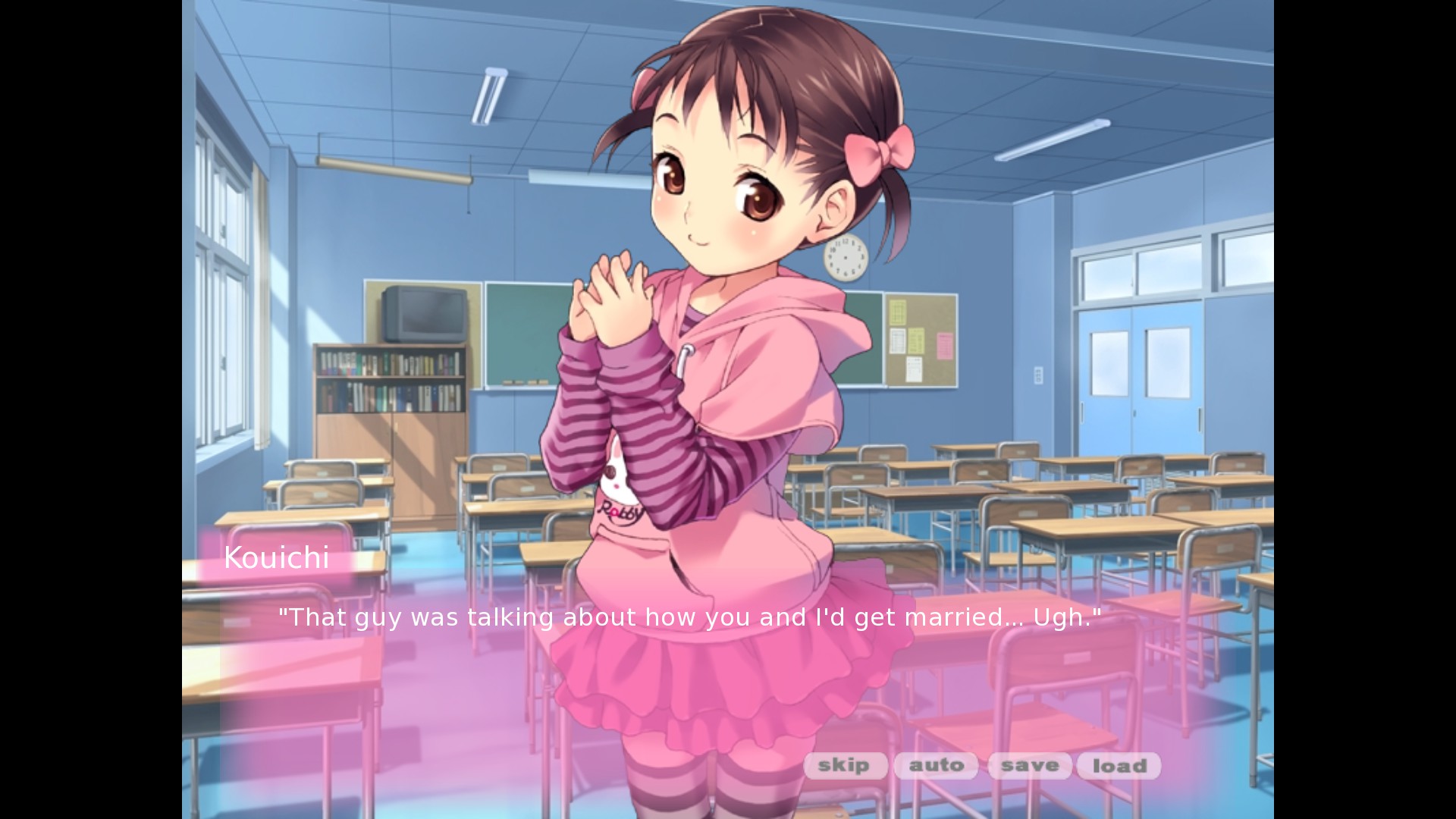
Pretty much all of these are in full play with Kouichi except that, slightly more realistically, Kouichi has no qualms getting some benefits with his friendship… after passing through puberty, at least.
Hikaru Genji plot
A key part of game is that, since you interact with Kaname from an early age, you have an influence over her as she grows up, which in turn shapes her interests. One major path branching decision early on involves whether Kouichi will agree to marry her when she asks all the way back in elementary school. Refusing outright leads to later vignettes and choices where Kaname tries to win Kouichi over, while agreeing to marry if she gets rich and buys him more games is a sort of shortcut that prevents decisions where you could lock yourself out of the good endings, but also kind of robs you of content you’d otherwise see.
Another seemingly major handful of decisions involve whether you try to push Kaname to start reading all the same mangas and watching the same animes as Kouichi does.
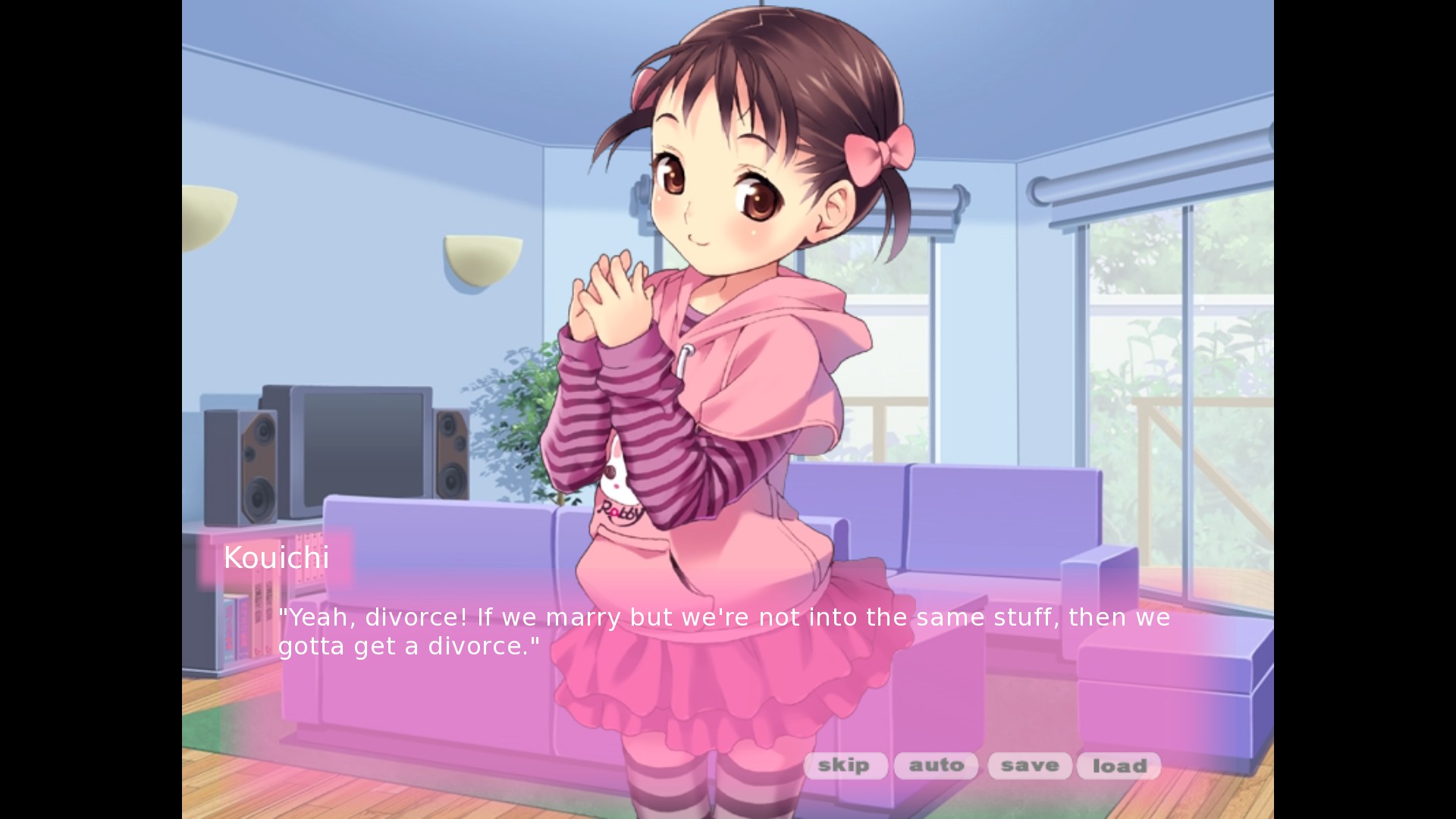
That said, playing through it multiple times, I could still get Kaname excited to go shopping for Naruto mangas as a middle schooler even when I hadn’t pushed her to read Turn A Gundam stuff as a first grader. It kind of stings and takes some of the mystique out of the game to realize that I’m not exploring a path so branching as I thought I was, but I guess this is a game with only one writer.
The one path where it does absolutely matter, however, is the one where you can show Kaname a porn doujin after having dragged her into the same manga and anime fandoms. This leads to a path of Kaname becoming a hardcore yaoi fangirl (or gay fan fiction) and eventually doujin artist.
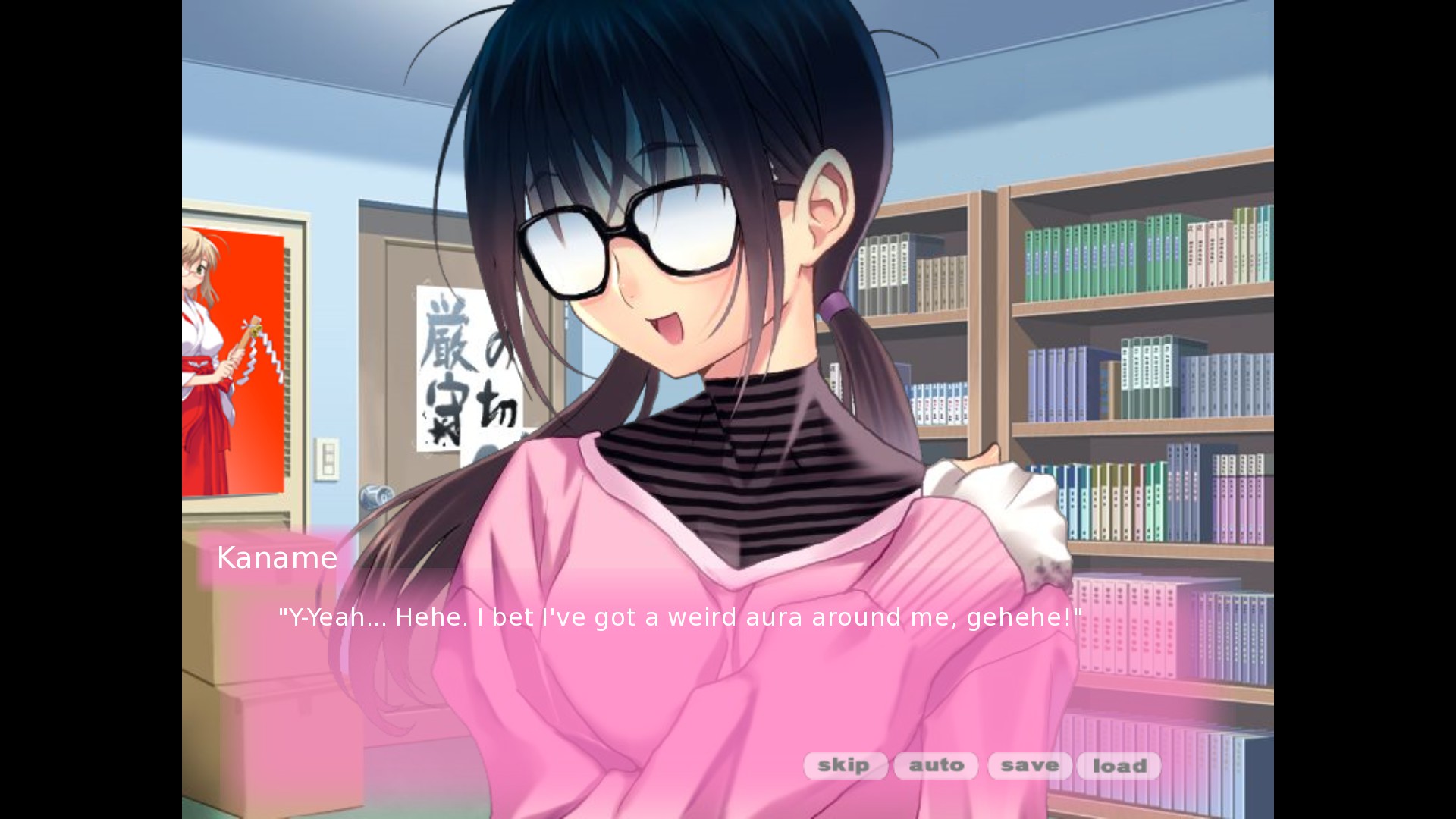
Are those some references?
What makes up the bulk of the game’s dialogue, especially towards the earlier portions of the game when the characters are being established, rather than when it’s talking about their relationship, are numerous vignettes between the two characters talking about various pop culture things they like. The game very pointedly opens stating that the first grader characters watch Turn A Gundam and go to see Yu-Gi-Oh when it first comes out in theaters in 1999. The pair of them toss back and forth lines from popular animes of the time. This isn’t “haha, the joke is that I just delivered a line from a famous movie” humor, it’s just two characters that constantly pull pop culture into their conversations.
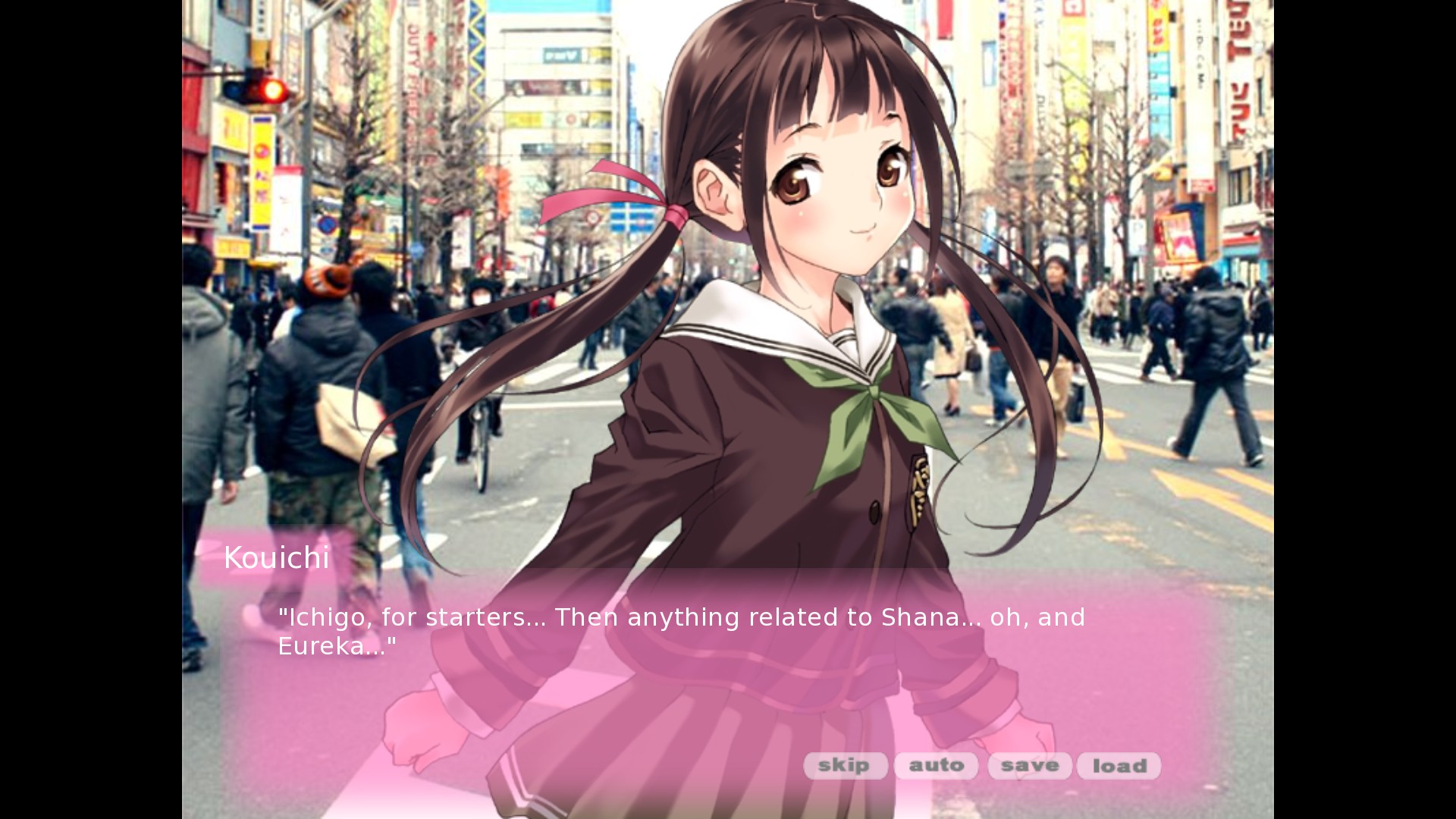
How you’ll feel about this probably depends an awful lot on whether you get those references, which is to say anyone who was born outside the age range of 1980 to 2000 is probably going to get little out of the references and hence the game as a whole. Rather than being random reference jokes, this is pure bathing in nostalgia, trying to take you back to a time where you as a young presumable nerd back then would talk to your friends constantly about the shows you watched as a kid and made pop culture references a normal part of your conversation. Except, this time it’s with a girl who wants to marry you and also watches all the same shows. Also, this game is Japanese, so you need to specifically have been into anime like Yu-Gi-Oh and games like Final Fantasy as a kid, to up the nerd quotient even further.
Speaking of the emotional reaction of me as a reader of this nostalgia trip, however, the game is essentially wish-fulfillment in the department of having a girlfriend who grew up with you and will watch all the same stuff you watch and play all the same things you play, but… what I’m feeling isn’t so much a vicarious joy as a burning envy after all the times I couldn’t get any friends over to play some Battletech with me when I was growing up.
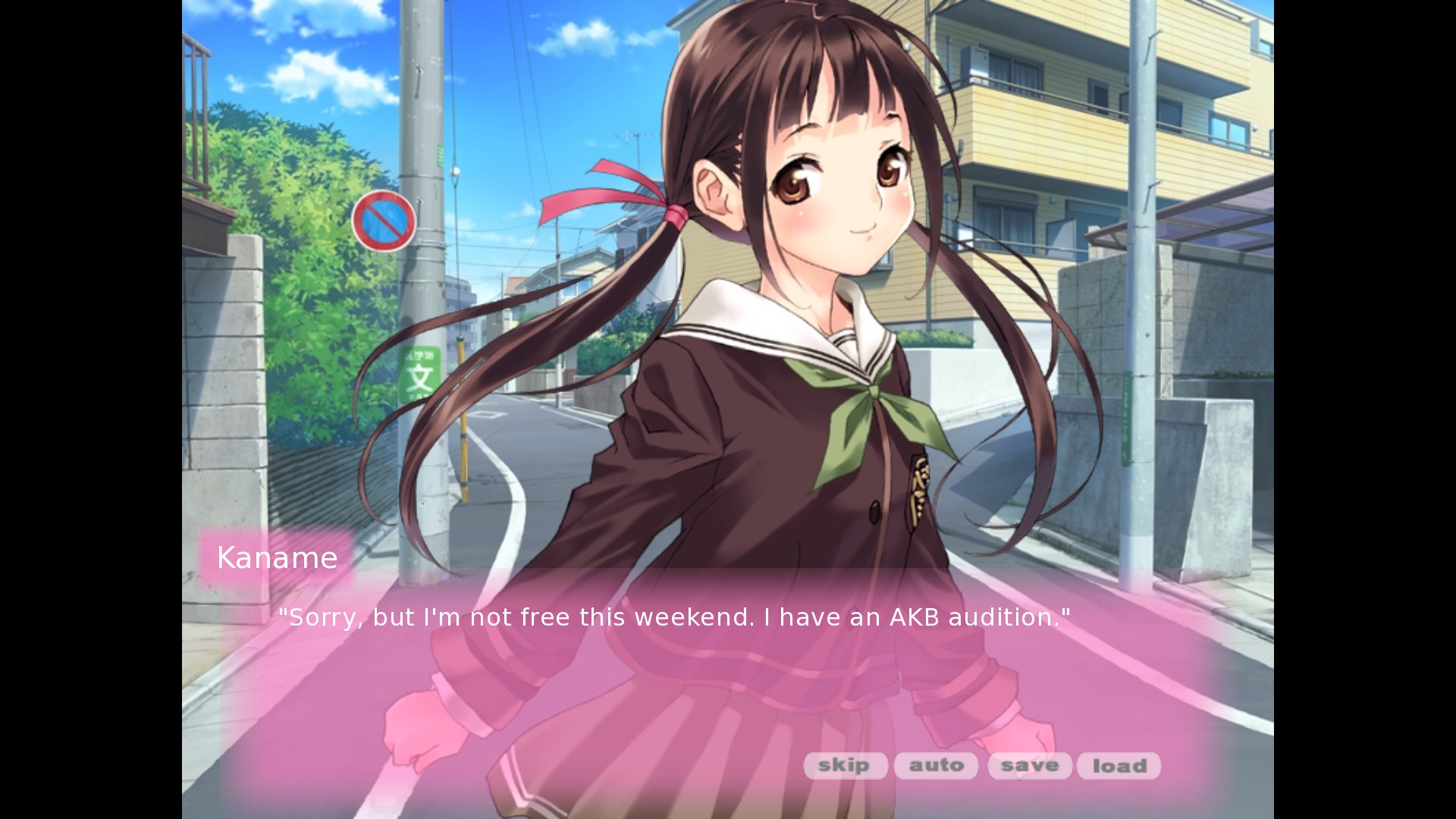
The R18+ patch
So, this is a light-hearted, humorous rom-com game, right? Totally harmless and safe to recommend to anyo– wait, what’s this? Apparently, I once again pulled a critical research failure before selecting this game, because it apparently has a decensor patch available on Denpasoft (warning, link very Not Safe For Work). I’m not showing any of the screenshots of the sex scenes since I think this game stands on its merits without needing the patch, so I don’t want to have to age gate this review.
Adding in the patch adds in the sex scenes in the later time periods of the game (obviously/thankfully) where Kaname is a high schooler or older.
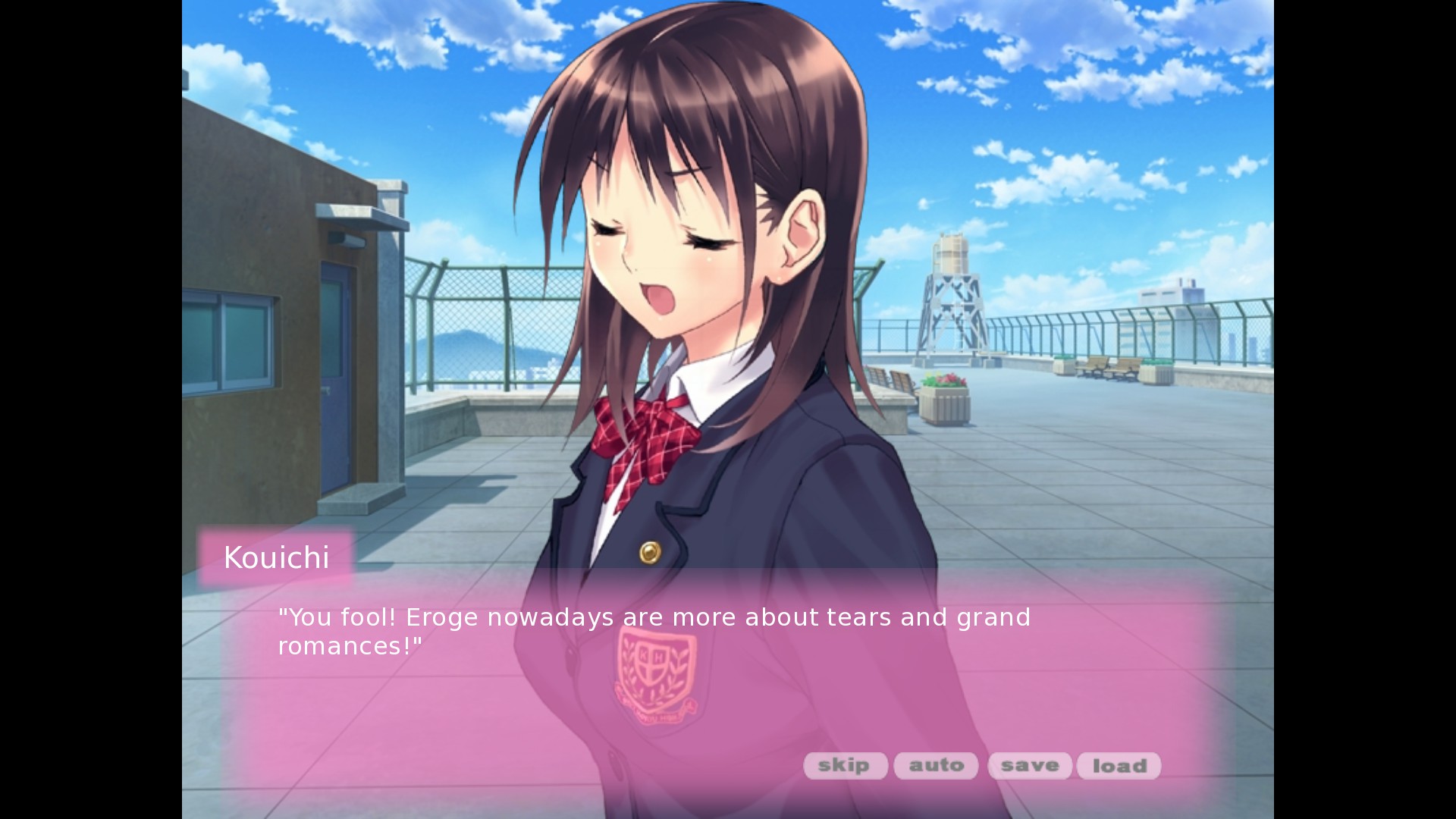
On the one hand, these scenes in places feel like they come from nowhere. After affirming that they’re going out, the couple immediately jump into a sex scene. The voice acting also seems to get noticeably lazy in these scenes. They’re not particularly riveting stuff, and I honestly want to just get back to the funny banter parts, but the sex scenes start to get in the way.
On the other hand, comparing the two versions of the game directly, you can feel where the censored version has conversations cut off abruptly to avoid the sex scene. In one scene on the “Kaname becomes a nerd” path, she cosplays as an anime character for Comiket and asks Kouichi to sell her doujin for her while she’s in the cosplay corner. In the uncensored version, he agrees on the condition they do it while she’s in cosplay, and it jumps into a sex scene. In the censored version he just says no, and the scene abruptly ends and goes on to the next scene.
You probably know whether you want the R18+ patch or not without me telling you, but the game is perfectly enjoyable without it being porn. I just wish more time was spent in the censored version bridging the scenes together more seamlessly.
Multiple endings
It’s not hard to find the “best” endings, and since there’s an achievement for each one, it seems that the “they had a kid” ending is the most frequently obtained one. That said, exploring every branch to get every ending kind of leads inevitably towards hinting towards an underlying philosophy in how the “choice and consequence” portion of the game is driven.
Specifically, a major turning point in a game about growing up with a literal girl next door childhood friend is whether you go to the same school or not, and the decisions that lead to whether Kouichi studies hard and gets into a good high school (these are based upon passing tests in Japan just like colleges everywhere else) basically amount to “try and study even a little” or “naaah, I can’t be bothered.” The game then harps on how Kaname is just plain smarter than Kouichi from then on in a way it just doesn’t when they do go to the same school. There’s a painful melancholy to that branch where Kouichi laments not getting into the same school as his crush which is sharpened by how trivial clicking the button to try a little, or the amount of dialogue spent on how he’s studying are in this game. Especially in a game that’s meant to feel so nostalgic, having a storyline that basically shows how your life could have been demonstrably better if you just tried a little harder can’t help but dump a massive weight of guilt on a player who is otherwise connecting to this character.
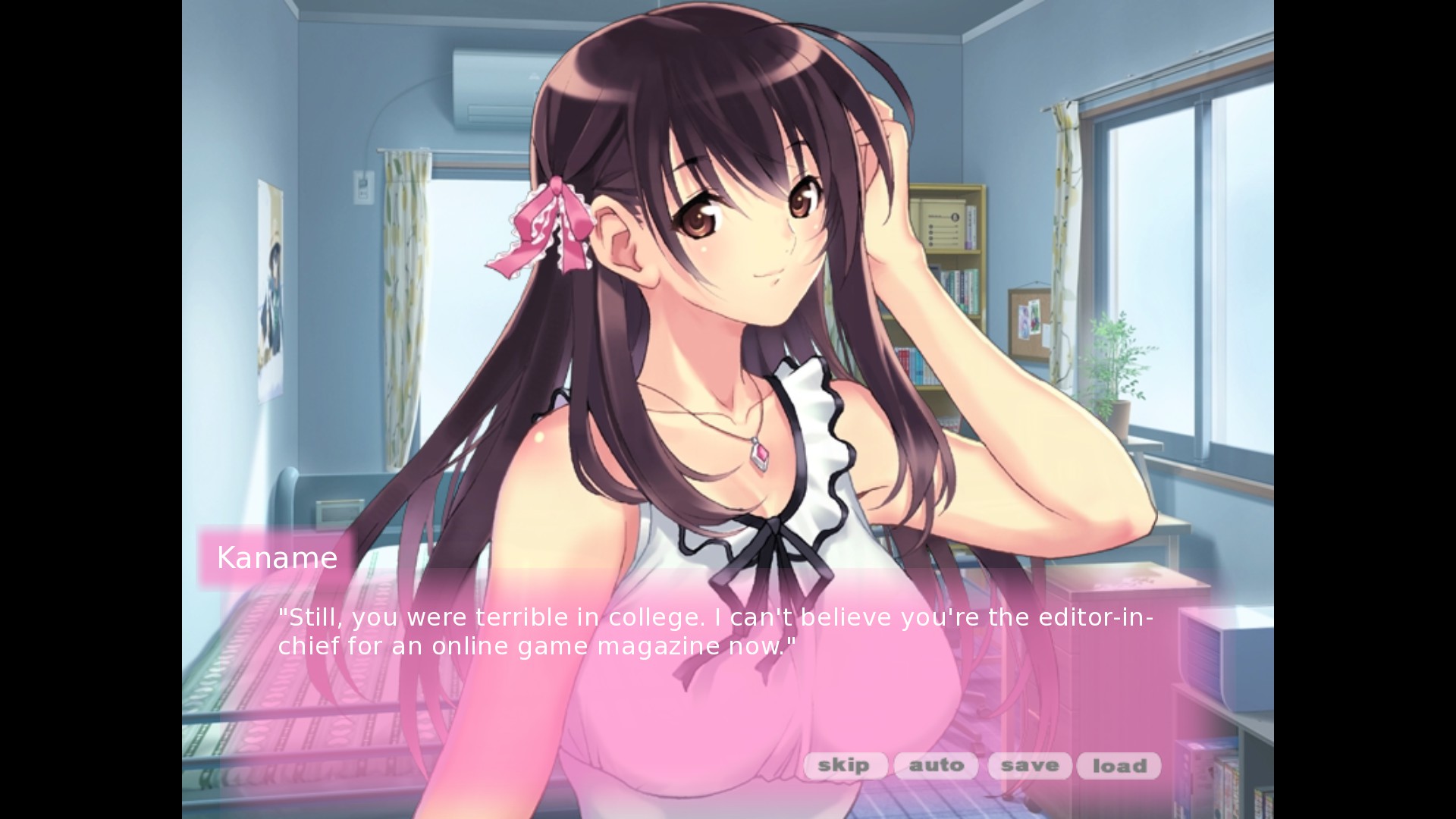
Likewise, even if you’re going down the “good path”, a choice between whether you ask Kaname to come back to the house (for sex) or just go to the arcade differentiates whether they get married (and possibly have a kid in a later choice) or whether they never go out at all and they’re just friendzoned forever. It smacks pretty heavily of the “Chad and virgin” meme where if you don’t spring for sex the first time you can, you’ll forever be a lonely virgin who can’t even ask out the girl who’s obviously in love with you.
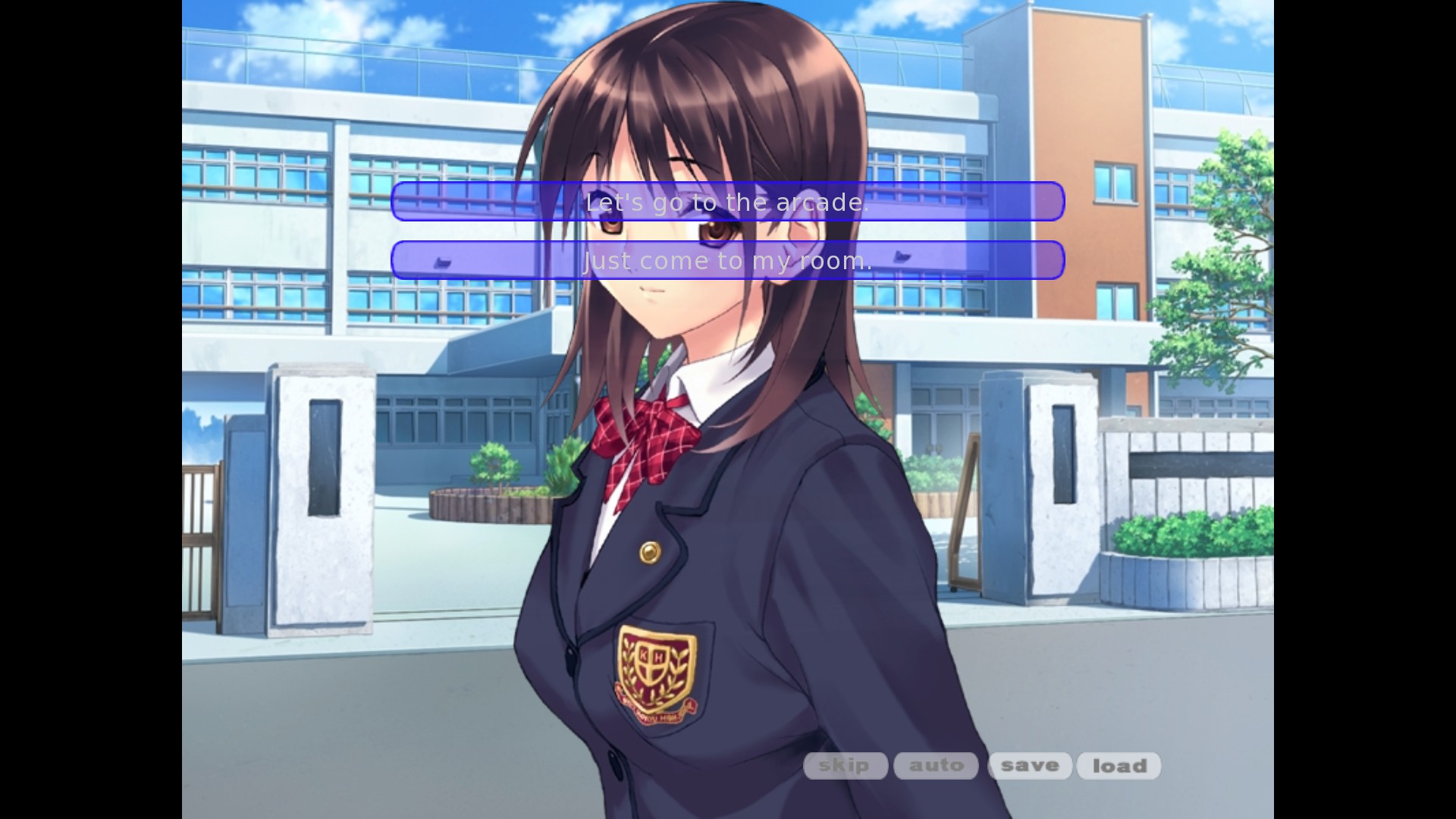
It’s sort of an inevitable feature of choice and consequence games that they need to have really dramatic consequences, but there’s something that feels a little off about the most dramatic turning points feeling so trivial in the context of the two characters spending most of their time talking about video game characters or what anime they’re watching.
Sound
The game’s credits list essentially three names as doing most of the work – the artist, the writer, and the voice actress, and then two companies are named for sound effects and music. This very likely means it’s royalty-free music they picked from a library. The sounds that aren’t Kaname’s voice are fairly generic, and you can turn them off without missing much.
Graphics
What you see in the screenshots (except for the lewds I’m not posting because I don’t see a reason to age-gate this) is basically what you get. There are no animated frames or other special effects. There are several different facial expressions on Kaname, but generally, the game consists of a background with this time period’s Kaname’s image standing directly center camera performing the dialogue to you.
Verdict
Real Life Plus is a fairly short game. In this case, that’s probably a good thing as it means it doesn’t wear out its welcome, and it’s on the cheaper end of the spectrum of indie games, at that.
The main selling point of the story is in its dialogue deliberately designed to evoke Millenial-generation nostalgia for getting hyped about popular games and animes with your friends. How much this game will resonate with you depends entirely upon how much you either personally connect to the pop culture references they make or at least can substitute in Star Wars or whatever you geeked out about with your friends as a kid whenever Gundam comes up in the story.
Beyond that, this is a doujin game made basically entirely by three people with very little budget, so the limitations sadly show with some limited branching paths.
All told, however, it’s also a game that had very little negative associated with it. I enjoyed the mood it brought up, and depending on the ending you get, it can end off on a sweet and light-hearted note.










